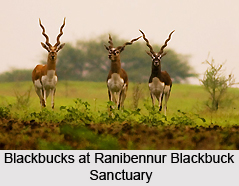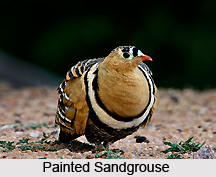 Ranibennur Blackbuck Sanctuary is situated in Haveri district of the south Indian state Karnataka. It was given the status of a sanctuary on 17th of June 1974 primarily for the protection of blackbucks. Two detached zones constitute the sanctuary known as an eastern and a western bit. Eucalyptus plantations and scrub forest are the dominant vegetations of this region. Although Great Indian Bustard is a resident of the sanctuary, it has not been spotted here much since the year 2002. Ranibennur Blackbuck Sanctuary is surrounded by agricultural fields.
Ranibennur Blackbuck Sanctuary is situated in Haveri district of the south Indian state Karnataka. It was given the status of a sanctuary on 17th of June 1974 primarily for the protection of blackbucks. Two detached zones constitute the sanctuary known as an eastern and a western bit. Eucalyptus plantations and scrub forest are the dominant vegetations of this region. Although Great Indian Bustard is a resident of the sanctuary, it has not been spotted here much since the year 2002. Ranibennur Blackbuck Sanctuary is surrounded by agricultural fields.
Geography of Ranibennur Blackbuck Sanctuary
Ranibennur Blackbuck Sanctuary is located at a distance of about 301 kilometres from Bengaluru and 8 kilometres from Ranebennur town. For administrative purposes, the sanctuary has been divided into three blocks namely Alageri, Hunasikatti and Hulathi. The core zone of the sanctuary encompasses an area of 14.87 square kilometres whereas its buffer-cum tourism zone covers an area of 104.13 square kilometres.
Flora of Ranibennur Blackbuck Sanctuary
 Till the year 1956, the main vegetation of Ranibennur Blackbuck Sanctuary constituted Carissa auriculata, Dodonea viscose, Prosopis juliflora and Acacia catechu. Later Eucalyptus and some indigenous species were planted in order to increase the vegetation cover of the sanctuary. Presently, the top canopy of the sanctuary includes mostly Eucalyptus along with some Albizzia amara and Hardwickia species. The lower and middle canopy comprises Cassia auriculata, Randia sp, Lantana camara, Zizyphus mauritiana, Acaxia sundra, Dodonea viscose, Prosopis juliflora and Acacia catechu. Scrub vegetation is found mostly in the western region. Patches of Subabul has also been planted in the sanctuary. Other flora of the sanctuary includes Ficus spp., Madhuca indica, Holoptelia integrifolia, Azadirachta indica, Cassia fistula and many more.
Till the year 1956, the main vegetation of Ranibennur Blackbuck Sanctuary constituted Carissa auriculata, Dodonea viscose, Prosopis juliflora and Acacia catechu. Later Eucalyptus and some indigenous species were planted in order to increase the vegetation cover of the sanctuary. Presently, the top canopy of the sanctuary includes mostly Eucalyptus along with some Albizzia amara and Hardwickia species. The lower and middle canopy comprises Cassia auriculata, Randia sp, Lantana camara, Zizyphus mauritiana, Acaxia sundra, Dodonea viscose, Prosopis juliflora and Acacia catechu. Scrub vegetation is found mostly in the western region. Patches of Subabul has also been planted in the sanctuary. Other flora of the sanctuary includes Ficus spp., Madhuca indica, Holoptelia integrifolia, Azadirachta indica, Cassia fistula and many more.
Fauna of Ranibennur Blackbuck Sanctuary
Ranibennur Blackbuck Sanctuary hosts a large population of blackbuck and wolf. Mammals of the sanctuary include Pangolin, Hare, Common Mongoose, Porcupine, Langur, Jackal, Fox and Wild Pig. The Harinigudda area of the sanctuary shelters Hyenas. Since its establishment the sanctuary has witnessed a constant rise in the population of blackbucks. Great Indian bustard has also been spotted in the sanctuary and its highest estimate in the sanctuary has been 14. Other avifauna of the sanctuary includes Black Drongo, Baybacked Shrike, Painted Sandgrouse, Large Grey Babbler, Sirkeer Cuckoo and Peafowl.
Visiting Information
Ranibennur Blackbuck Sanctuary is best visited during the period of October to March, however the Great Indian bustard can be seen in the sanctuary from February to June. On the sanctuary boundary, at Gangajala, a forest rest house provides accommodation to the tourists.











